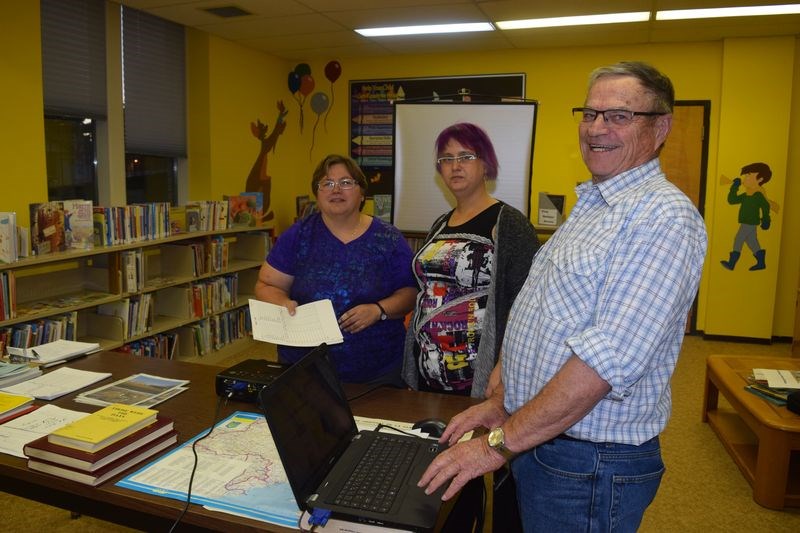How to delve into one’s past and the many stories that can be discovered when doing so were the main topics of discussion at the Kamsack Library last week
Two members of the Yorkton Genealogical Society, Cindy Koreluik of Kamsack, the treasurer of the Yorkton society, and former Kamsack resident Gerald Moriarty, led a spirited discussion on how one can search for information on one’s past.
A member of the Society for 19 years, Koreluik outlined the resources one would need in order to do the research and make appropriate records of one’s findings, while Moriarty demonstrated how one can do much research using the computer and seeking out sites with the records one needs.
She distributed copies of forms which one would need when doing family research, which included a family unit chart, a pedigree chart, research log and a correspondence log, and explained how each may be used.
The Yorkton Genealogical Society, which is a member of the Saskatchewan Genealogical Society, functions basically as a support group, Koreluik explained, adding that members of the Society support one in their search, offering advice and suggestions, but “do not do the research for you.”
It takes time, lots and lots of time, Moriarty said as he explained how to access the sites and how to keep looking until one finds the information one is looking for and confirmation of that information.
Koreluik explained how much of her research was into Ukrainian culture and immigration, while Moriarty, who said he has traced his family to 1600s, has looked into Irish, German and American historical records.
Moriarty said he has much of this information because in his research, luckily he had discovered a distant family member who had already done much of the research so that he was merely able to adapt it into his own family tree.
To get into building a family tree one must start with oneself, Koreluik said. Start with what is known, gather information and ask family members to obtain as much information as one can.
Koreluik and Moriarty emphasized the importance of recording oral history on sound or videotape because “once the seniors are gone, you lose a lot of history.”
Koreluik explained how she has visited many cemeteries to glean information from tombstones and explained how some genealogical societies take on projects such as making records of cemeteries.
Libraries are a great resource, they said, listing local history books and newspaper clippings, especially obituaries.
Using an overhead projector connected to his laptop computer, Moriarty showed how one can access various sites to find information and recommended the CanGeneology website and a Doukhobor genealogy site that is operated by John Kalmakoff.
Moriarty recommended people look at Canadian census and immigration records; birth, death and baptismal records, and ship passenger lists.
“Just don’t give up,” he said. “Sometimes you feel as though you’re going round and round in circles and getting nowhere. It can be frustrating and confusing, but you may soon find information that correlates with what you want to know.
“Also, use your imagination. Use your instincts and remember the stories that your grandparents told you.”
Moriarty explained how for some information the websites charge a fee, but often that information can be obtained at another website that can be searched at no charge.
Although the group had met to discuss genealogy, often the discussion moved into history and questions of family history and community history were asked and discussed.
Moriarty used examples from those attending the meeting to find birth or death records of several of their ancestors and said he would like to get high school students more interested in history and in particular into genealogy.
“Kids today know their way around modern technology and communication, so it should be relatively easy for them to do such research,” he said.
“There’s great satisfaction in finding traces of members of your family,” he said. “Everyone wants to know where they came from.”




